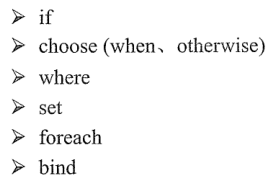1、Mybatis采用功能强大的基于ONGL的表达式来完成动态SQL。
2、ONGL常用的元素有:

1》if
<if test="id != null "> and id = #{id} </if>
Mybatis中,#{id}表达式获取参数有两种方式:一是从HashMap中获取集合中的property对象;二是从Java Bean中获取property对象。
2》choose
<choose> <when test="id != null"> and id = #{id} </when> <when test="loginname != null and password != null"> and loginname = #{loginname} and password = #{password} </when> <otherwise> and sex = '男' </otherwise> </choose>
3》where
<where> <if test="state != null "> state = #{state} </if> <if test="id != null "> and id = #{id} </if> <if test="loginname != null and password != null"> and loginname = #{loginname} and password = #{password} </if> </where>
where元素知道只有在一个以上的if条件有值的情况下才去插入where子句。而且,如果最后的内容是“and”或“or”开头,where元素也知道如何将它们去掉。
4》set
update tb_employee <set> <if test="loginname != null">loginname=#{loginname},</if> <if test="password != null">password=#{password},</if> <if test="name != null">name=#{name},</if> <if test="sex != null">sex=#{sex},</if> <if test="age != null">age=#{age},</if> <if test="phone != null">phone=#{phone},</if> <if test="sal != null">sal=#{sal},</if> <if test="state != null">state=#{state}</if> </set> where id=#{id}
set元素可以动态前置set关键字,同时也会消除无关的逗号。
5》foreach
<select id="selectEmployeeIn" resultType="com.lfy.bean.Emp"> SELECT * FROM tb_employee WHERE ID in <foreach item="item" index="index" collection="list" open="(" separator="," close=")"> #{item} </foreach> </select>
该元素主要应用于构建in条件语句。doreach元素的功能非常强大,它允许指定一个集合,声明可以用在元素体内的集合项和索引变量。也可以指定开闭匹配的字符串以及在迭代中间放置分隔符。
6》bind
<select id="selectEmployeeLikeName" resultType="com.lfy.bean.Emp"> <bind name="pattern" value="'%' + _parameter.getName() + '%'" /> SELECT * FROM tb_employee WHERE loginname LIKE #{pattern} </select>
bind元素可以从ONGL表达式中创建一个变量并将其绑定到上下文。